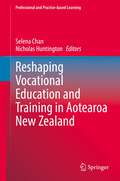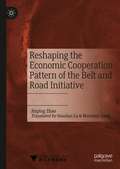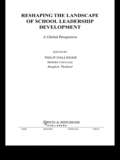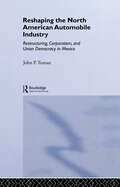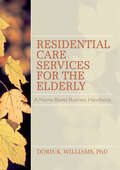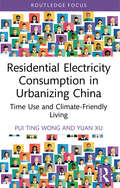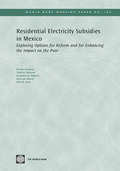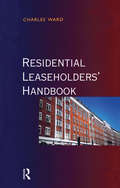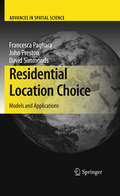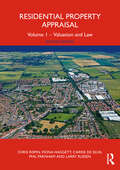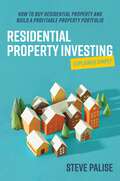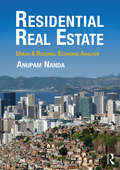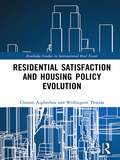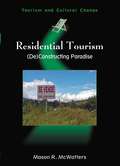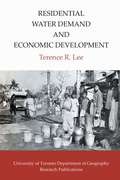- Table View
- List View
Reshaping Vocational Education and Training in Aotearoa New Zealand (Professional and Practice-based Learning #34)
by Selena Chan Nicholas HuntingtonThis book contributes extensively to a better understanding of how vocational education and training (VET) and practice-based learning and teaching is developed and designed. It presents examples of vocational education as an ongoing dialogue, continually refreshed through engagement between educators and learners, Māori, employers, industry, and others. It demonstrates how the needs of learners can be met through relevant models of delivery, and how organisations and individuals work towards equity of access and parity of outcomes for all.It details the origins, purposes and evolution of vocational organisations, initiatives supporting Māori and Pasifika success and women in traditionally male-dominated occupations, the roles, provisioning and impact of foundation VET across different contexts, innovations through Certificate, Diploma and Degree programmes of learning, the contribution of new technologies to learning approaches, and the efficacy of education and professional development for VET teachers.This collection of chapters illustrates how Aotearoa New Zealand’s VET system is responding to challenging and changing environments through new frameworks of practice, approaches, and models of delivery. As an overview of a system in change, it is of interest to VET educators, system managers, and policy makers.
Reshaping the Asia Pacific Economic Order (PAFTAD (Pacific Trade and Development Conference Series))
by Christopher Findlay Hadi SoesastroRelationships and alignments among the nations of the world’s most populous and productive region, the Asia Pacific, are in flux. Current global political, economic and security uncertainty, heightened by 9/11 and the subsequent War on Terror, has fuelled a reassessment by many Asia Pacific nations about the structure and form of future economic and political cooperation and development. Featuring contributions from some of the most eminent and influential economists and political scientists in the Asia Pacific region, this book explores the forces reshaping the Asia Pacific economic order, and where these changes may lead. Focusing on the origins of the shift towards policy driven integration, the book examines what new structures may eventually emerge on both sides of the Pacific, the ways in which this shift will affect the progress of economic integration and how cross-Pacific relations will therefore be affected.
Reshaping the Economic Cooperation Pattern of the Belt and Road Initiative
by Jinping ZhaoThis book focuses on the important theme of economic cooperation along the Belt and Road. Starting from an analysis of current situation, the book defines the cooperation direction and specific tasks for extensive fields and goes on to provide a systematic analysis of the cooperation mechanism, trade, investment, infrastructure construction, energy and industry park cooperation along the Belt and Road. Using in-depth research on the situation, opportunities and challenges in pushing forward the economic cooperation along the Belt and Road, the author puts forward policy suggestions on the way forward.
Reshaping the Landscape of School Leadership Development: A Global Perspective (Contexts Of Learning Ser.)
by Philip HallingerReshaping the Landscape of School Leadership Development: A Global Perspective traces developments in this arena as they evolved since 1980. The book is comprised of chapters authored by the leading scholars in the fields of educational leadership and school leadership development from the United States, Canada, Europe, Asia, and Australia. The vol
Reshaping the North American Automobile Industry: Restructuring, Corporatism and Union Democracy in Mexico (Routledge Studies in Employment and Work Relations in Context)
by John P. TumanThis work examines the responses of unions and workers to regional integration and restructuring in the automobile industry in North and Central America. The focus is on the automobile industry in Mexico, which, because of its size and importance, is viewed as a strategic sector of the Mexican economy and was the focal point of talks between the US, Canada and Mexico during negotiations on NAFTA. Focusing on the period from 1980, John P. Tuman examines the changes implemented by firms to promote export production, he explores reasons for the variation in labour responses to restructuring, and he discusses the prospects for cross-border organizing and co-operation among automobile workers in Canada, the US and Mexico.
Reshore Production Now: How to Rebuild Manufacturing and Restore High Wages, High Profits, and National Prosperity in the USA
by William A. LevinsonThis book addresses the vital importance of reshoring US manufacturing capability to ensure economic and military security and then discusses the proven methods that the United States used to gain manufacturing supremacy in the first place. The vital takeaway is: If the job can be made sufficiently productive, the per-unit labor cost ceases to be relevant which means a business can pay high wages, realize high profits, and deliver low prices simultaneously. The contest is then not between high wages and cheap labor, but between efficiency and inefficiency and, when automation is involved, machine against machine. Readers will be able to put these principles to work very quickly to achieve tangible results. The relatively low Federal minimum wage has meanwhile become a major issue, but inflation skyrocketed in the second quarter of 2022 when higher wages, and higher demand for goods and services, were not matched with higher productivity. The book addresses the relationship between the money supply and the velocity of money to prices, wages, and productivity. A manufacturing resurgence in the United States will not only increase our standard of living enormously but generate taxable economic activity that will help pay down rather than increase the Federal debt. Higher productivity also delivers a greater supply of goods to accompany higher wages, and thus works against inflation. This can prevent looming recessions and disruptions.
Residencial Los Andes
by Nicolas P. Retsinas Lisa StropePeninsula Investment Group is deciding wether or not to recapitalize an equity investment in a Residencial Los Andes, a residential project in Santiago, Chile, or take a substantial loss. The project did not met its sales goals and the bank pressured the investors to liquidate the construction loan. Early on, Peninsula had identified Chile a target market, however, in investing in Residencial Los Andes, it had made several exceptions to it's investment strategy. The case addresses what went wrong in the evolution of the project, what measures need to be taken if Peninsula did increase it's capital committment.
Resident Duty Hours: Enhancing Sleep, Supervision, and Safety
by Committee on Optimizing Graduate Medical Trainee (Resident) Hours Work Schedules to Improve Patient SafetyMedical residency in the United States aims to prepare recent medical school graduates to practice medicine independently. One fundamental requirement of resident education is in-depth, firsthand experience caring for patients. During the three to seven years of training, residents often work long hours with limited time off to catch up on their sleep. They can experience fatigue on the job, contributing to increased errors and accidents. However, many medical educators believe extensive duty hours are essential to provide residents with the educational experiences they need to become competent in diagnosing and treating patients. Resident Duty Hours: Enhancing Sleep, Supervision, and Safety, a December 2008 report from the IOM, asserts that revisions to medical residents' workloads and duty hours are necessary to better protect patients against fatigue-related errors and to enhance the learning environment for doctors in training. The report recommends that residency programs provide regular opportunities for sleep each day and each week during resident training. In addition, it recommends that the Accreditation Council for Graduate Medical Education provide better monitoring of duty hour limits and that residency review committees set guidelines for residents' patient caseload. Patient handover procedures and supervision of residents should also be strengthened. Until these changes take place, residency programs are not providing what the next generation of doctors or their patients deserve.
Residential Care Services for the Elderly: Business Guide for Home-Based Eldercare
by Doris K WilliamsAs the elderly population continues to increase, the need for suitable housing will continue to rise as well. This handbook is designed to help individuals and families determine the feasibility of starting a small home business providing residential home services for one or more elderly persons. Persons interested in starting a business of this type will find this unique book a goldmine of important information. Residential Care Services for the Elderly is a valuable decision-making tool which helps readers determine if this type of business venture is appropriate and, if so, how to start and maintain a residential care service for the elderly. Thorough coverage of background and implementation details provides potential operators with a rationale and necessary information. Numerous self-assessment and resource inventories in this practical handbook will guide readers in determining their areas of interests and competencies. Opportunities for networking among state licensing/standards agencies, funding agencies, and a listing of elder care organizations and advocacy groups adds value to this time-saving resource, ensuring a quicker and more likely success. Case studies, detailed guides, and the discussion of positive and negative aspects of being the owner of a small residential care business, based on interviews with people currently running elder care residential services, are also included. All aspects of business operations are covered in Residential Care Services for the Elderly, including sources of funding and potential incomes; emotional and financial cost/benefit factors; parameters of organizing the business including personnel, respite care workers, need for registered nurses, and food service; special needs of clients; details of financial plans with outlines and sample forms; and variables of success and failure. Graduate and undergraduate students taking classes in regard to gerontological business and long-term care related alternatives will also find this statistic-filled handbook a useful reference.
Residential Carpentry: Student Guide Level 2
by Nccer StaffThe material in this textbook will help you prepare for a career in residential carpentry.
Residential Electricity Consumption in Urbanizing China: Time Use and Climate-Friendly Living (Routledge Focus on Energy Studies)
by Yuan Xu Pui Ting WongThis book forges a link between residential CO2 emissions and time use, focussing on China as a key case study. To provide a better understanding of the energy implications of the lifestyle differences between urban and rural China, Pui Ting Wong and Yuan Xu utilise time-use methodology as an alternative way to explore the links between individual lifestyle and residential electricity consumption. They begin by examining how Chinese citizens divide their time between daily activities, highlighting patterns around indicators including age, gender, education, and economic status. They go on to quantify CO2 intensities of these time-use activities. Through this linkage, this book presents an alternative strategy for climate-friendly living, highlighting the ways in which urban planning can be deployed to help individuals adapt their time-use patterns for CO2 mitigation. Providing a novel contribution to the growing literature on residential electricity consumption, Residential Electricity Consumption in Urbanizing China will be of great interest to scholars of climate policy, energy studies, time use, and urban planning.
Residential Electricity Subsidies in Mexico
by Todd M. Johnson Kristin Komives John R. Scott Jonathan D. Halpern Jose Luis AburtoLarge and growing subsidies to residential consumers in Mexico have become a major policy concern. This report explains the growth of subsidies, the current distribution of subsidies across income classes, and uses utility and household survey data to simulate how alternative subsidy mechanisms could improve distributional and fiscal performance. The goal is to help inform discussion in Mexico about how to reduce subsidies and redirect them toward the poor. The findings also offer lessons for other countries that are planning tariff reforms in their electricity sectors.
Residential Institutions in Britain, 1725–1970: Inmates and Environments (Perspectives in Economic and Social History #27)
by Jane HamlettThe essays in this collection explore both organizational intentions and inhabitants' experiences in a diverse range of British residential institutions during a period when such provision was dramatically increasing.
Residential Leaseholders Handbook
by Charles WardThe Residential Leaseholders’ Handbook explains in plain language everything leaseholders and their advisers need to know in relation to long residential leases. Among the common problems it tackles are absent landlords; spiralling service charges; the right to be consulted on significant or long term service charge items; how to challenge excessive charges; how to gain control from difficult or exploitive landlords and how to set up a management company. The book begins with the legal framework of a typical ground lease and its main provisions including: responsibility for repairs, insurance and management of a building, the meaning of the covenant for "quiet enjoyment" and the termination of a lease due to overdue rent. The author explains what lenders look for in a residential lease; how leaseholders can insist that their lease is amended to meet lenders’ requirements and the issues relating to assignment, subletting and alteration of leasehold premises.Extensive use of real life scenarios, landmark cases and some fictitious case studies illustrate how leasehold law works in practice and enables readers to effectively assess their position. Written in non-technical language this book is a reliable source for leasehold management companies, managing agents, legal advisers, students and residential leaseholders.
Residential Location Choice: Models and Applications
by John Preston David Simmonds Francesca PagliaraThe effective planning of residential location choices is one of the great challenges of contemporary societies and requires forecasting capabilities and the consideration of complex interdependencies which can only be handled by complex computer models. This book presents a range of approaches used to model residential locations within the context of developing land-use and transport models. These approaches illustrate the range of choices that modellers have to make in order to represent residential choice behaviour. The models presented in this book represent the state-of-the-art and are valuable both as key building blocks for general urban models, and as representative examples of complexity science.
Residential Property Appraisal: Volume 1 - Valuation and Law
by Phil Parnham Chris Rispin Carrie de Silva Fiona Haggett Larry RussenResidential Property Appraisal, Volumes 1 and 2 are essential handbooks not only for students studying surveying but also for surveyors and others involved in the appraisal of residential property. Volume 1 has been updated and covers the valuation process as it relates to residential properties, particularly when valuation is undertaken for secured lending purposes. It addresses the basic skills required, the risks posed in a valuation, the key drivers of value, emerging issues that impact valuation and the key legal and RICS Regulatory considerations that a valuer needs to understand. Volume 2 of the book goes on to address the inspection and survey of residential properties, covering new technology, modern methods of construction, problem plants and pests, damp in new builds, and modern building services. New challenges for the surveyor to consider include the health and well-being of building occupants, the Party Wall etc. Act 1996 and schedules of condition, energy and building performance, and owner-occupied and tenanted properties. An essential book for students studying to enter the residential survey and valuation profession and for existing practitioners who wish to improve their knowledge of industry practices.
Residential Property Appraisal: Volume 2: Inspections, Defects and Reports
by Phil Parnham Larry RussenResidential Property Appraisal, Volumes 1 and 2, are handbooks not only for students studying residential surveying but also for those involved in the appraisal of residential property. Volume 1 has been updated and covers the valuation process as it relates to residential properties, particularly when valuation is undertaken for secured lending purposes. It addresses the basic skills required, the risks posed in a valuation, the key drivers of value, emerging issues that impact valuation and the key legal and RICS regulatory considerations that a valuer needs to understand. Volume 2 of the series goes on to consider the practical aspects of the survey and inspection of residential properties in more detail. Not only does this include updated sections on the most common defects (for example, building movement, moisture problems, wood rot and wood-boring insects), it also covers emerging challenges, including assessing personal safety hazards, modern construction technologies and materials and invasive plants. The volume also takes account of the Home Survey Standard recently published by the RICS and the changes resulting from climate change, the energy crisis and concerns about fire safety. Building services in domestic residential properties is another area of rapid change, especially with the development of low-carbon and renewable technologies. To ensure that this aspect is covered in sufficient detail, the content is to be included in Volume 3: Assessing Building Services. An essential book for students studying to enter the residential survey and valuation profession and for existing practitioners who wish to improve their knowledge of current practices.
Residential Property Investing Explained Simply: How to buy residential property and build a profitable property portfolio
by Steve PaliseThe essential handbook for all residential property investors.Many property investing books sell the dream – scores of properties bought in a handful of years, and millions of dollars made in a number of minutes. But how does property investing actually work?Unlike other property books, Residential Property Investing Explained Simply comprehensively explains how to invest in residential property. It covers planning your investment strategy, searching for and analysing opportunities, building a residential property portfolio, finding and managing tenants, and much, much more.If you want to grow your wealth through residential property investing and start your journey toward financial freedom, this is the only book you will ever need.
Residential Real Estate: Urban & Regional Economic Analysis
by Anupam NandaResidential Real Estate introduces readers to the economic fundamentals and emerging issues in housing markets. The book investigates housing market issues within local, regional, national and international contexts in order to provide students with an understanding of the economic principles that underpin residential property markets. Key topics covered include: Location choice in urban areas Housing supply and demand Housing finance and housing as an asset class Demographic shifts and implications for housing Sustainable homes and digitalisation in housing Drawing on market-level information, readers are encouraged to recognise the supply and demand drivers and modelling of dynamic housing markets at various spatial scales and the implications of trends within an urban and regional context, e.g. urbanisation, ageing population, migration, digitalisation. With research-based discussions and coverage of relevant literature, this is an ideal textbook for students of residential real estate, property and related business studies courses at UG and PG levels, as well as a reference book with research topics for researchers. This book will also be of interest to professionals and policymakers.
Residential Satisfaction and Housing Policy Evolution (Routledge Studies in International Real Estate)
by Clinton Aigbavboa Wellington ThwalaThis book explores residential satisfaction and housing policy trends in developing nations by using subsidised low-income housing examples in South Africa, Ghana and Nigeria as case studies. While there has been much documentation on the formation of residential satisfaction and the evolution of housing policy in developed nations, relatively little has been written about these topics in developing nations. This book provides readers with two major practical insights: The first is focused on the theoretical underpinning of residential satisfaction and the formation of residential satisfaction in subsidised low-income housing through the development of a conceptual framework, while the second is focused on housing policy evolution and its trends in South Africa. In this section of the book, comparative overviews of public housing in two West African countries are provided with an emphasis on the philosophical basis for its development in these countries. The central aim of the book is to provide readers with ideas on residential satisfaction formation and housing policy trends in South Africa.
Residential Tourism
by Mason R. McwattersResidential Tourism: (De)Constructing Paradise offers the first in-depth, critical exploration of the foreign retirement/expatriate communities proliferating in both size and number throughout Latin America. Amidst the widespread development and promotion of international destinations of residential "paradise" intended for retirement, leisure, and experiences of exotica, this book draws on a diversity of perspectives in order to analyze the social and spatial impacts that dynamic phenomenon has on the people and places it directly affects at the local level. Utilizing the community of Boquete, Panama as a case study, this book examines how two diverse residential groups - the native community who have lived in the area for generations and the foreign residential tourists who have just recently relocated abroad - coexist in a shared place of home, define their experiences of place and community, and confront the mass development of residential tourism in Boquete.
Residential Water Demand and Economic Development (The Royal Society of Canada Special Publications #2)
by Terence LeeIn the last twenty years the problem of urban public water supples has become increasingly serious. Disparities between the effective supply of, and demand for, water has grown rapidly and now constitute a danger to public health. This study deals with the place of urban public water supplies in economic development and with the demand for such elements of the social infrastructure during the process of economic and social growth. Based on an examination of the existing water-use systems in two urban areas in India, this study provides valuable information in a field that is of growing concern to all the developing countries of the world.
Residual Income Valuation Model
by Charles C.Y. Wang Albert ShinThis note explains the residual income valuation model (RIM), how it relates to "traditional" valuation models, the intuition behind its use, and empirical research related to its value relevance. RIM is theoretically equivalent to the dividend discount model and the discounted free cash flow model. However, it expresses future cash flows to equity in terms of accounting measures of capital (e.g., book value of equity) and performance (e.g., return on equity). Implementing the RIM requires forecasting the amount of expected future "economic profits," which depends on how business strategy plays out in the context of industry competitive dynamics, effective management of financial capital, and governance.
